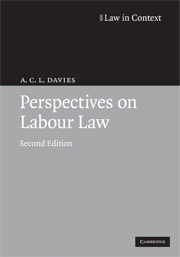Book contents
- Frontmatter
- Contents
- Preface
- Acknowledgements
- Table of statutes
- Table of statutory instruments
- Table of EU legislation
- Table of international instruments
- Table of cases
- Abbreviations
- PART I
- 1 A brief history of labour law
- 2 Economics perspectives on labour law
- 3 Human rights perspectives on labour law
- 4 Modes of regulation
- PART II
- Index
3 - Human rights perspectives on labour law
Published online by Cambridge University Press: 28 January 2010
- Frontmatter
- Contents
- Preface
- Acknowledgements
- Table of statutes
- Table of statutory instruments
- Table of EU legislation
- Table of international instruments
- Table of cases
- Abbreviations
- PART I
- 1 A brief history of labour law
- 2 Economics perspectives on labour law
- 3 Human rights perspectives on labour law
- 4 Modes of regulation
- PART II
- Index
Summary
As we saw in Chapter 1, human rights perspectives on labour law first gained ground in the 1970s. Commentators began to realise that collective bargaining could not provide all the protection workers needed. In the 1980s, labour rights became highly controversial. The government was keen to uphold workers' rights in some settings but not in others. It wanted to enforce individuals' rights against trade unions (arguing that unions treated individuals unfairly), but it did not want to enforce individuals' rights against firms (because it believed in keeping the labour market as free of regulation as possible). Today, rights perspectives on labour law are very common in the literature. Many commentators use rights language in order to evaluate the current law, and in doing so they draw heavily on international and regional standards. The HRA 1998 has reinforced the rights perspective by giving greater effect to some human rights in English law.
This chapter will begin with a historical introduction to the development of human rights, focusing in particular on labour rights. This will give you an overview of the international and regional human rights instruments that will be discussed throughout the book. The second section of the chapter will turn to the complex questions of interpretation surrounding human rights: who can claim a right and against whom can they bring their claim? What exactly does any given right protect? And how (if at all) can we justify interfering with a right?
A brief overview of human rights
Since much of the discussion in this book will involve detailed examination of particular human rights, it is helpful to start with an overview of international and European human rights law.
- Type
- Chapter
- Information
- Perspectives on Labour Law , pp. 38 - 56Publisher: Cambridge University PressPrint publication year: 2009



